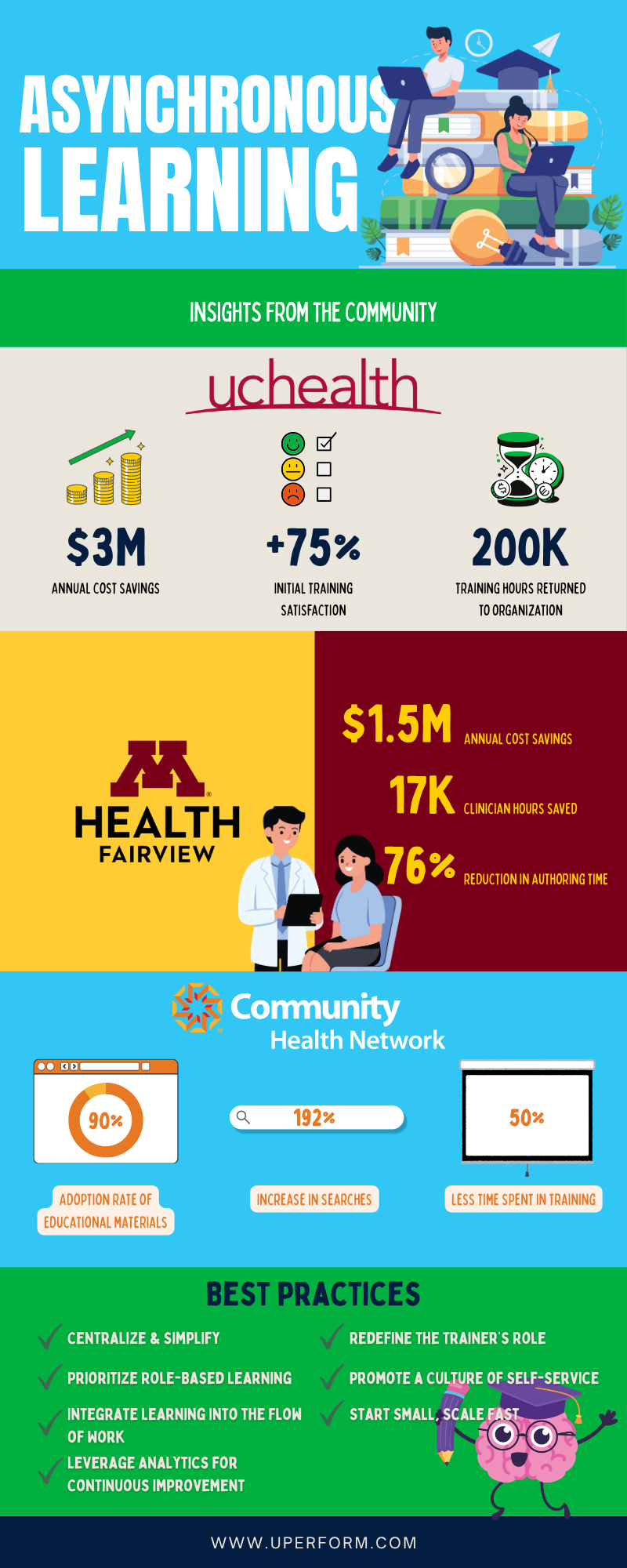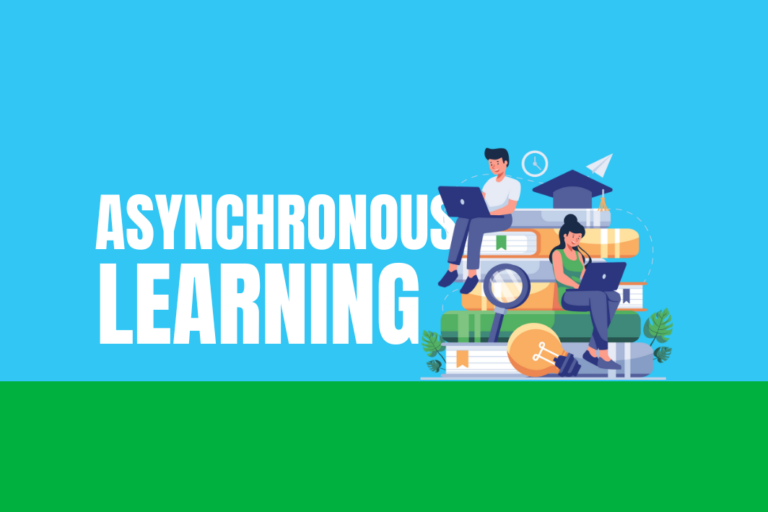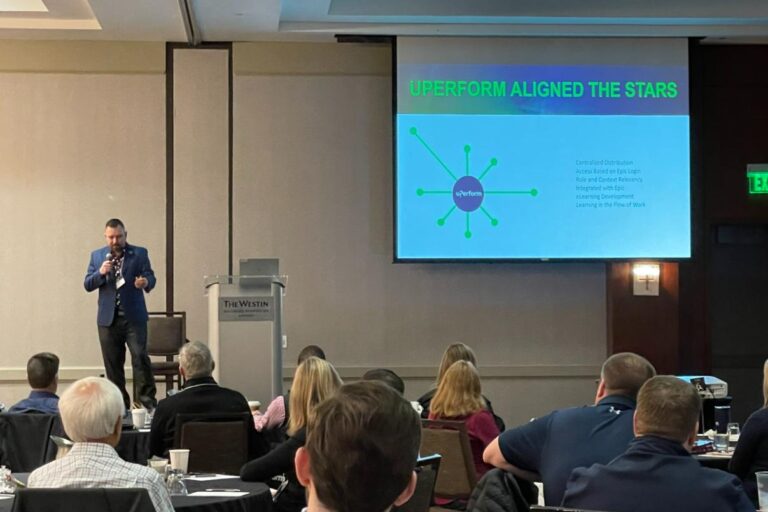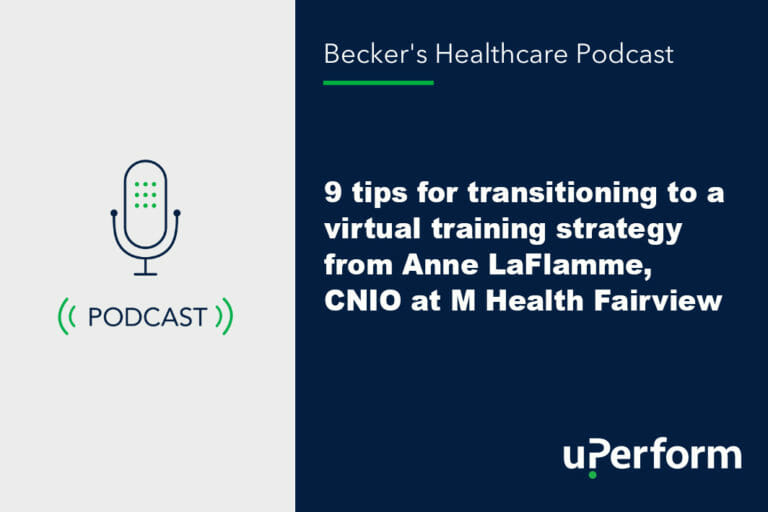In healthcare, change is constant. With regular technology updates, staffing challenges, merger and acquisition activity and the ongoing need for efficiency, health systems are realizing that traditional classroom training simply can’t keep up.
Across the uPerform community, leading organizations are proving that asynchronous learning – flexible, self-paced education available on demand – can improve adoption, satisfaction and performance at scale, while delivering a significant return on investment for the organization.
From UCHealth successfully scaling an overhaul of its training strategy across its growing system, to M Health Fairview’s multimillion-dollar savings and Community Health Network’s culture of self-service, this year’s presentations from uPerform clients reveal a powerful blueprint for the future of learning in healthcare.
This article rounds up the best client presentations from 2025 and summarizes best practices and lessons learned from our clients that are moving the needle on asynchronous training in healthcare.
What is Asynchronous Learning in Healthcare?
Asynchronous learning refers to education that does not occur at a set place or time. Many healthcare organizations are struggling with tight budgets, frequent technology updates and staffing shortages and turnover. Asynchronous learning offers a cost-effective solution for addressing these challenges while better supporting clinicians.
Instead of attending a scheduled class, clinicians access virtual courses, or short, interactive learning modules, videos and job aids on demand. This type of valuable microlearning is often integrated directly within their electronic health record (EHR) and other clinical systems to deliver just-in-time support.
This model offers numerous benefits for clinicians, including:
- Flexibility: Learners engage when and where they need it without disrupting patient care.
- Relevance: Content can be personalized to specific roles, departments or workflows.
- Better Accessibility: With learning opportunities available directly in the workflow, clinicians know exactly where to go for help — there’s no need to wait for additional training opportunities or contact the help desk.
- Higher Satisfaction: Clinicians who have access to asynchronous learning consistently report higher levels of satisfaction.
Asynchronous learning also provides benefits to the organization:
- Scalability: Training can reach thousands of employees simultaneously, especially beneficial to small teams with limited resources.
- Sustainability: Asynchronous learning minimizes repetitive instruction and reduces the strain on training teams.
- Time and cost savings: A self-paced, virtual learning strategy eliminates the need for formalized training in the classroom, saving time and money.
By delivering training on demand, or in the flow of work, asynchronous learning ensures that clinicians have access to the right knowledge at the right time, enhancing both confidence and performance.
To learn more, see our guide: “Stepping Outside the Classroom: Transitioning to Computer-Based Training.”
Scaling Success: UCHealth Gets New Hires on the Floor Faster
UCHealth showcased its success with a reimagined training strategy at this year’s Epic XGM conference.
As one of the nation’s fastest-growing health systems, UCHealth faced an all-too-common challenge: how to scale Epic® training across multiple hospitals and affiliates while ensuring standardization and efficiency.
The solution: UCHealth partnered with uPerform to support its transition to virtual, self-directed learning. The system’s current training strategy begins with a self-paced virtual onboarding course with intervaled, self-paced learning through clinicians’ first 90 days on the job. As a result, UCHealth is now onboarding new hires in a fraction of the time:
“Then we have the uPerform self-paced learning [in Epic], which can be up to three hours. At the end of which, here’s your login. Go start taking care of patients. So, in as quick as about two hours, you’ve gone from ‘I need to get trained’ to ‘I can start taking care of patients.’” – Dr. CT Lin, CMIO at UCHealth
During and after onboarding, clinicians also have access to a centralized learning library, accessible from within Epic. Clinicians now access role-based, microlearning content directly within their workflows with uPerform Copilot. Learning materials are searchable via the Learning Library and content embedded directly in Epic.
Results:
- $3 million annual cost savings
- 200,000 training hours returned to the organization
- 75% increase in initial training satisfaction
- 27% boost in self-reported Epic efficiency
- 28% increase in nurses agreeing that Epic enhances clinical practice
By transitioning to an virtual Epic training strategy, trainers are freed up to focus on higher-value coaching and optimization. UCHealth’s journey highlights how asynchronous learning can help training teams deliver and scale successful outcomes that benefit clinicians and the organization.
“Having one source of truth at everybody’s fingertips was very, very important to us.” — Kelley Williamson, Director of IT, UCHealth
Faster, Better, Cheaper: M Health Fairview’s Asynchronous Learning Revolution
When M Health Fairview shifted to asynchronous learning, its goal was clear: deliver training that’s faster, better, and more cost-effective without sacrificing quality. The results speak for themselves.
Results:
- $1.5 million annual cost reduction
- 17,000 clinician hours saved
- 76% reduction in authoring time for training content
- 19-point higher Net EHR Experience Score (NEES) for uPerform users
Derek Harley, Learning & Development System Manager, admits that he was at first uncertain about the transition to asynchronous training:
“I almost quit. I would not have believed we could be successful without classrooms, without physical contact, without being able to see your faces for understanding.” — Derek Harley, Learning & Development System Manager, M Health Fairview
Harley and his team recently transitioned the last of their 135 instructor-led classrooms to asynchronous eLearning courses. The move has allowed them to scale onboarding across Minnesota and Wisconsin, vastly reducing travel costs for in-person training. Its asynchronous approach also delivers ongoing learning to Epic users through embedded content in the workflow, self-guided pathways and Epic F1 dashboards.
When user adoption of a new Epic eConsent tool lagged at just 7%, Fairview embedded a 90-second “how-to” video in the workflow with uPerform. Shortly after, adoption soared to 87%, demonstrating the power of just-in-time learning in the workflow.
Deeper adoption drove even greater results. Among “power users” who engaged with all uPerform touchpoints, satisfaction and confidence metrics improved by up to 38%.
Building a Culture of Self-Service: Community Health Network’s Knowledge+
At Community Health Network (CHNw), asynchronous learning has become more than a training method – it’s a culture shift. The Indiana-based health system branded its uPerform Learning Library as Knowledge+, creating a single hub for learning and support.
CHNw embedded Knowledge+ content throughout Epic, integrating links into dashboards, toolbars and navigators, so clinicians can find what they need without leaving their workflow.
Results:
- 90% adoption rate of educational materials
- 192% increase in searches
- 70% increase in content views
- 600+ training hours saved for nursing student onboarding
- 50% reduction in caregiver time spent in training
By introducing dual-track training for incoming physicians and APPs, CHNw tailored onboarding based on prior Epic experience. This strategy cut training time in half for experienced providers. It also helped CHNw achieve Epic Gold Stars Level 10 in 2024 and a 6.1 utilization score, with a goal of reaching 6.5 in 2025.
“Now that people know where [to find training resources] and you don’t need a Sherpa to get there, people can actually appreciate going and getting training resources on their own time.” — Jen Guenin, Digital Training & Support, Community Health Network
CHNw’s next evolution includes rolling out uPerform Copilot and Direct Answer, tools that surface AI-powered guidance and auto-summarized answers inside Epic, further increasing Epic efficiency while simplifying the clinician experience.
Insights from uPerForum: Community-sourced solutions
This year, uPerform hosted its 4th annual – and largest to date – uPerForum client summit. The annual summit brings together members of the uPerForum healthcare community to share challenges, lessons learned and best practices for driving success with health IT training strategies.
We’ve summarized some of the highlights from the event. You can also read a recap of uPerForum 2025 from Derek Harley, Learning & Development System Manager at M Health Fairview.
Baylor Scott & White Health (BSW): Unlock the Magic of uPerform Copilot, Your Epic Assistant
BSW’s presentation emphasized the importance of creating a trusted source of learning and delivering timely updates in Epic as key strategic pillars to building more confident, engaged, and empowered software users. BSW was the first client to partner with uPerform in the creation and deployment of uPerform Copilot – uPerform’s latest Epic integration delivering AI-assisted, integrated learning and change communications from anywhere within Epic. BSW witnessed a 60% increase in content engagement with its release of uPerform Copilot.
By shifting to self-serve workflow support, BSW has successfully trained and guided its Epic users through a double Epic upgrade and Beaker go-live by delivering a more personalized and consistent training experience throughout their locations across Texas.
Access Community Health Network (ACHN): My Chart, Care Everywhere & Compass Rose: Making the Untrainable Trainable
With a small team and lean budget, ACHN has been able to leverage asynchronous training to deliver support for “hard-to-train” workflows and tools. They found the most success by focusing on shortform content embedded directly in the workflow. By leveraging uPerform to build immersive, simulation-based training for Epic’s MyChart, Care Everywhere, and Compass Rose, the small training team of just four people has achieved remarkable results:
- 15–25% reduction in claim denials
- 30% drop in help desk requests
- 15–20 minutes saved per prior authorization, totaling over 130 hours saved each month
Froedtert Health: Journey to Direct Answer: Getting to the Answer Faster
Froedtert’s presentation at uPerForum 2025 focused on the challenge of getting clinicians to the support they need faster. First, they centralized learning content using uPerform’s Learning Library. Using analytics, they identified where users were struggling or abandoning searches and refined their content structure and content tagging strategy to address these areas.
Most recently, they’ve begun using uPerform’s Direct Answer feature to surface support directly in the workflow and provide faster access to step-by-step instructions.
This strategy has helped improve time-to-answer, increase content engagement and increase learner satisfaction.
UCHealth: From Good to Great: Mastering uPerform with Standards that Work
UCHealth’s presentation provided a detailed overview of how the organization evolved its training program by formalizing content standards, style guides and design governance for its uPerform implementation. These standards helped UCHealth ensure training consistency and quality across a rapidly growing organization, while supporting scalability and efficiency in content creation.
They even provided best practices for other organizations looking to establish their own content standards:
-
- Determine all content types that need standards (courses, simulations, managed documents, etc.)
- Identify learning elements to standardize (content structure, considerations for style, tone and voice, etc.)
- Document the standards clearly (consider publishing a style guide)
- Pilot and gather feedback
- Train the team
- Monitor and evolve
Best Practices for Establishing an Asynchronous Learning Strategy
The success of uPerform clients underscores one truth: asynchronous learning isn’t just about technology. It’s about strategy and culture. Here are seven key takeaways for healthcare organizations looking to modernize training:
-
- Prioritize Role-Based Learning
Deliver learning that’s specific to the user’s role, specialty and workflow. Personalization reduces information overload and increases retention. - Integrate Learning into the Flow of Work
Embed microlearning in the systems clinicians already use. Contextual, in-app learning supports adoption and reduces time away from patients. - Leverage Analytics for Continuous Improvement
Data drives better learning outcomes. Monitor engagement, search patterns and completion rates to refine your content strategy over time. - Redefine the Trainer’s Role
Shift educators from instructors to instructional designers and coaches. Focus their time on creating evergreen content, one-on-one support, mentoring and reinforcing learning through feedback and analytics. - Promote a Culture of Self-Service
Empower learners with one-click access to learning resources to find answers independently. CHNw’s Knowledge+ model shows that success comes from combining marketing, communication and accessibility. - Start Small, Scale Fast
Pilot new learning approaches in one department, measure results and build from there. Early wins help secure executive buy-in and funding.
- Prioritize Role-Based Learning
The Future of Learning in Healthcare
Across the uPerform community, asynchronous learning has driven measurable, organizational success:
- Millions in cost savings
- Tens of thousands of training hours returned to clinicians and training teams
- Significant gains in EHR satisfaction, confidence and efficiency
As we look toward 2026, the next frontier of asynchronous learning will be shaped by AI personalization, predictive analytics and more customized learning paths, ensuring every clinician has the support they need when they need it.
At uPerform, we’re proud to partner with healthcare leaders building smarter, more sustainable learning ecosystems and proving that better learning leads to better patient care.
Related Articles
Start your journey with asynchronous learning today
Looking for a better way to scale and deliver quality software training to your users? Contact us today to learn how uPerform is helping organizations shift to an asynchronous training model that saves time and money, while delivering results that matter.













